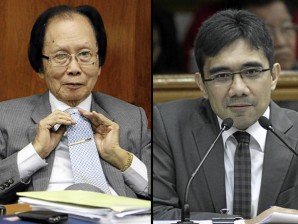After 33 days of trial, the defense and the prosecution panels finally agreed that only 21—not 45—purported properties of Chief Justice Renato Corona would be the subject of dispute in his impeachment trial.
Confusion over how many properties Corona and his family actually owned can be traced to a list provided by the Land Registration Authority (LRA) upon the request of Representative Niel Tupas Jr., the lead House prosecutor.
Based on the letter from LRA Administrator Eulalio Diaz III dated January 10, Tupas and his fellow prosecutors held press conferences accusing Corona of owning 45 properties, suggesting that his earnings in the government could not have allowed him to afford all of them.
Corona’s counsels and the prosecution lawyers on Wednesday stipulated before the impeachment court that 17 of the titles included on the LRA list were all “canceled titles.”
But private prosecutor Winston Ginez said one of these 17 titles—the one referring to the Ayala Heights property in Quezon City—was canceled only in 2010 and therefore was “still material for the years 2002 to 2009.”
Both camps also agreed that eight more titles in the LRA list were not under the name of Corona or his wife Cristina. The defense initially sought a stipulation on 12 titles, but Ginez said the prosecution was still “claiming” that Corona owned four of these properties.
The four disputed properties are the McKinley property in Taguig City, and the Quezon City properties in La Vista Subdivision, Cubao and Kalayaan Avenue.
“For purposes of clarity and accuracy, the court now instructs you to submit your respective memorandum on this issue and justify your position,” Senate President Juan Ponce Enrile, the presiding officer in the impeachment trial, told both the panels.
Enrile also granted the request by the lead defense counsel, Serafin Cuevas, that the four disputed properties, including the one in Ayala Heights, should be “the subject of evidence because this involved evidence of fact and not merely of law.”
“There are four (properties) in the excluded list and another one and I do not think that the memorandum will solve the validity of the claim of each of the contending parties here,” Cuevas told the court.
“So if it will not be asking too much, may we humbly request that evidence be required for purposes of enlightening the court as to the claim of both parties.”
Enrile then ruled: “I agree that that is the subject of proof. So ordered.”
La Vista property
Carlo Alcantara, the head of the Quezon City registry of deeds, earlier testified that Corona’s title for the Ayala Heights property was already a “canceled” title, the property having been sold on Feb. 26, 2010 for P8 million.
The 1,200-square-meter La Vista property now belongs to Corona’s daughter Carla and her husband, Constantino Castillo. The couple bought it from the Coronas for P18 million on Nov. 9, 2010, according to the testimony.
The same testimony showed that the Cubao property is under the names of Carla and Constantino Castillo after they bought it from Daniel Encina on Dec. 15, 2003, for P10.5 million.
The Castillos also own the Kalayaan property, which was bought on March 11, 2009, for P15 million. It has an encumbrance of P12 million borrowed from The Bank of the Philippine Islands, as shown in its transfer certificate of title.
At the start of Wednesday’s proceedings, the 84-year-old Cuevas apologized for missing the proceedings for the past two days. He was said to have suffered from vertigo.
But Enrile, 88, cut him off, saying he didn’t have to and that he understood the situation. “We are only human,” he said.
Early in the trial, the defense again presented Carmina Cruz, client relations officer of Alveo Land Corp., to prove that Corona did not have to declare his condominium unit at The Columns in Makati City prior to 2010, the year he finally did so.
Cruz testified that Mrs. Corona “accepted” the unit only on Aug. 12, 2009, even if the property was “deemed accepted” by the developer earlier on June 7, 2008.
No parity of facts
Senator Francis Escudero later clarified whether the defense had different positions when it came to The Columns unit (which prosecutors said should have been declared as early as in the 2004 SALN) and the Marikina property.
A bonzai artist, Demetrio Vicente, earlier testified that he had long been the owner of the 3,400-square-meter Marikina property even if he had not yet transferred the title in his name.
“Is my understanding correct that your theory is that if the property has not yet been delivered, it’s not yet owned by Chief Justice Corona and therefore should not be declared in his SALN yet?” Escudero asked Cuevas.
“On the other hand, even if (the property is) not yet registered, if it’s already delivered (it now belongs to the buyer as in the case of Vicente)?”
Cuevas replied that there was “no parity of facts” between the case of The Columns unit and the sale of the Marikina property to Vicente.
“The Vicente case deals with an existing property. In this particular instance, the contract to sell covers a property that still had to be constructed. It was not in existence (yet). So practically, it was a sale of a right,” the defense counsel argued.
